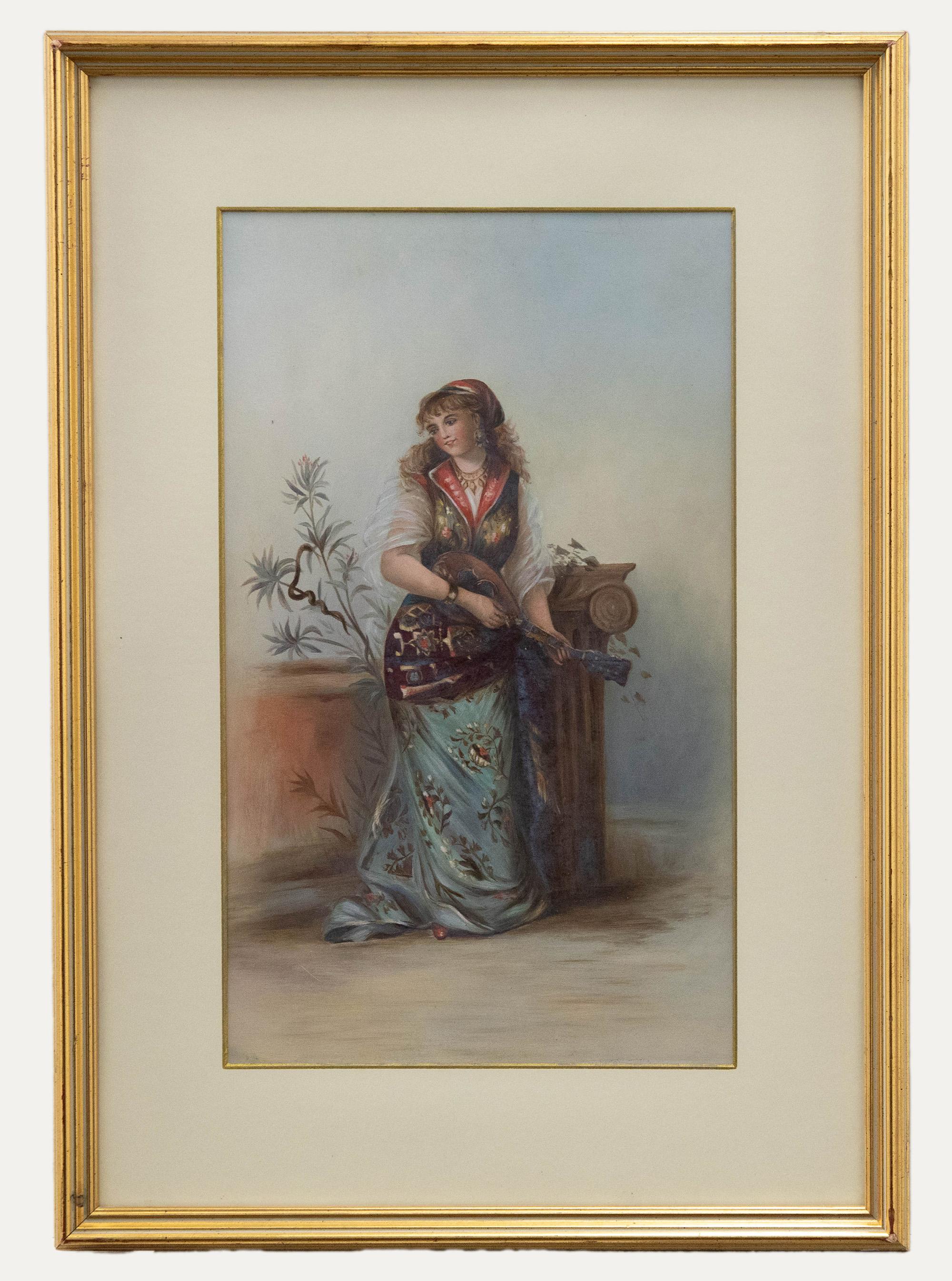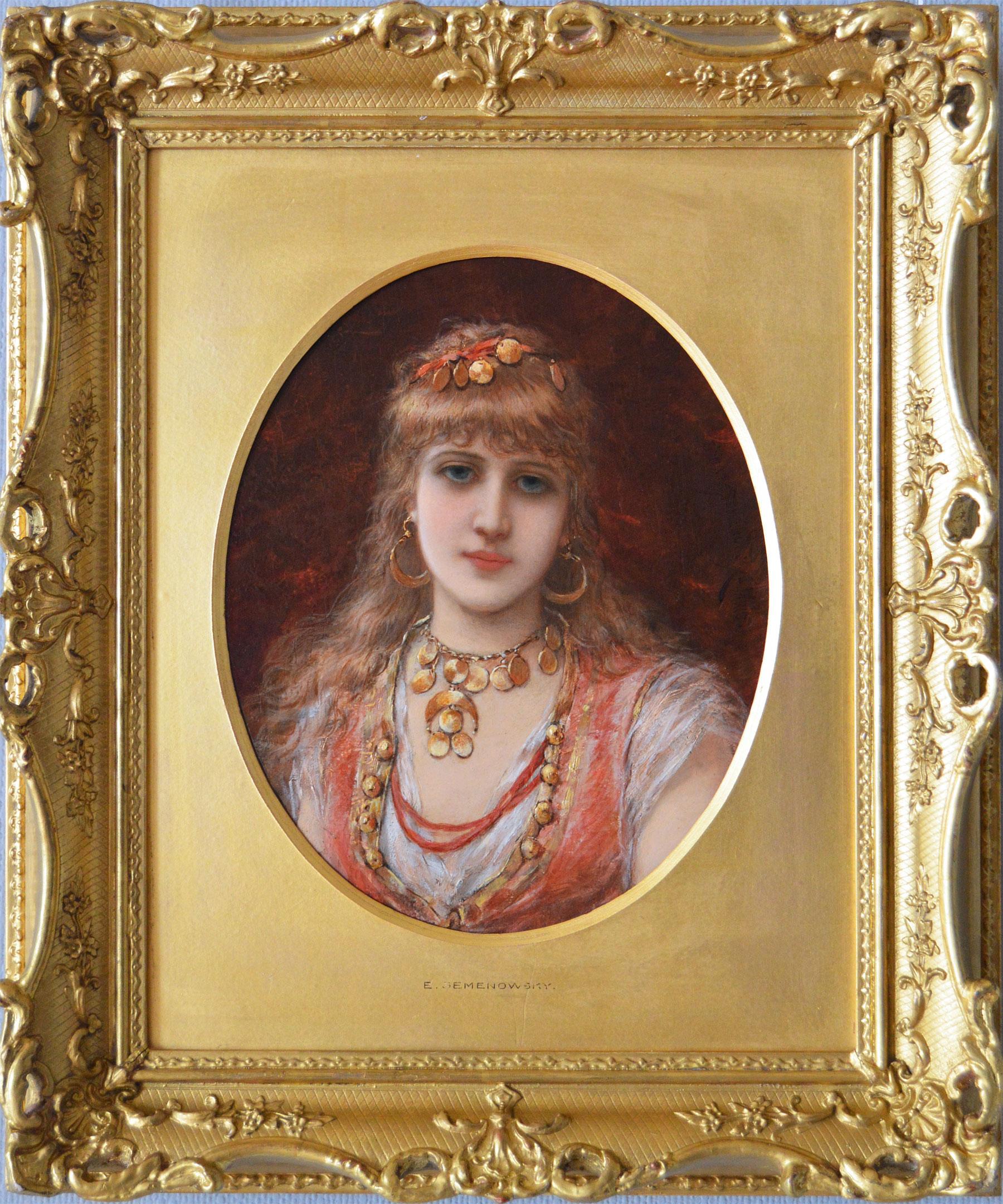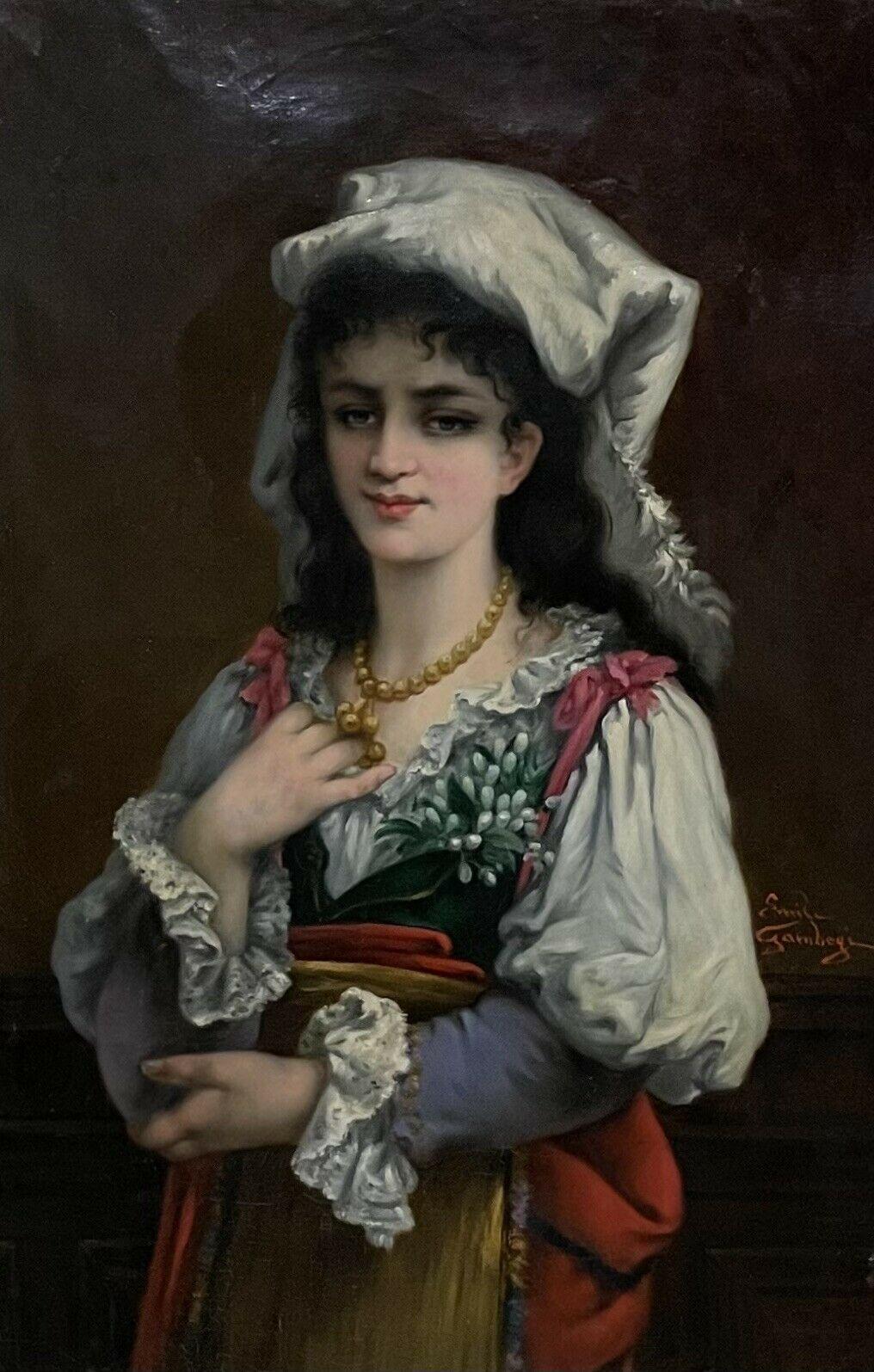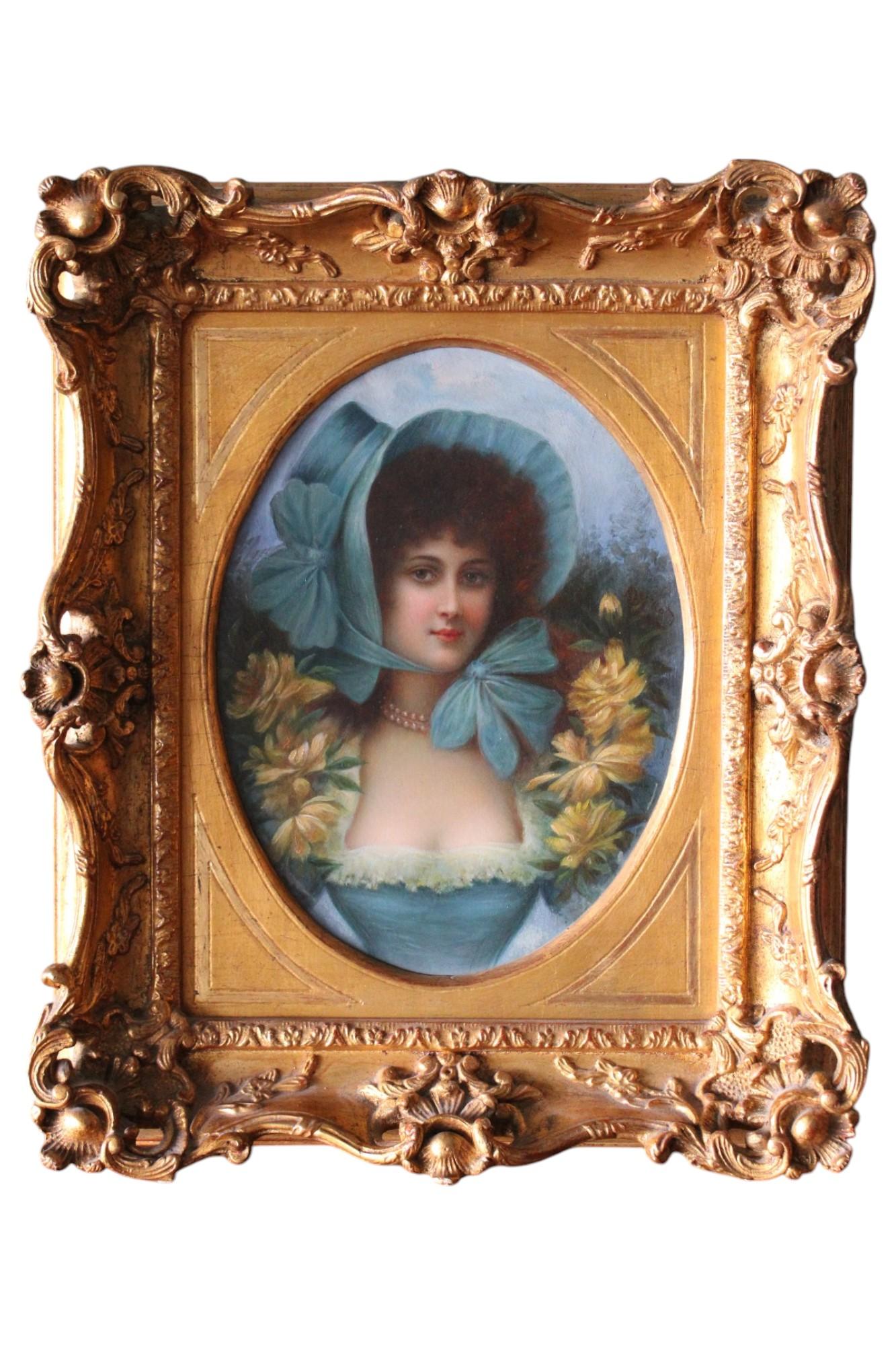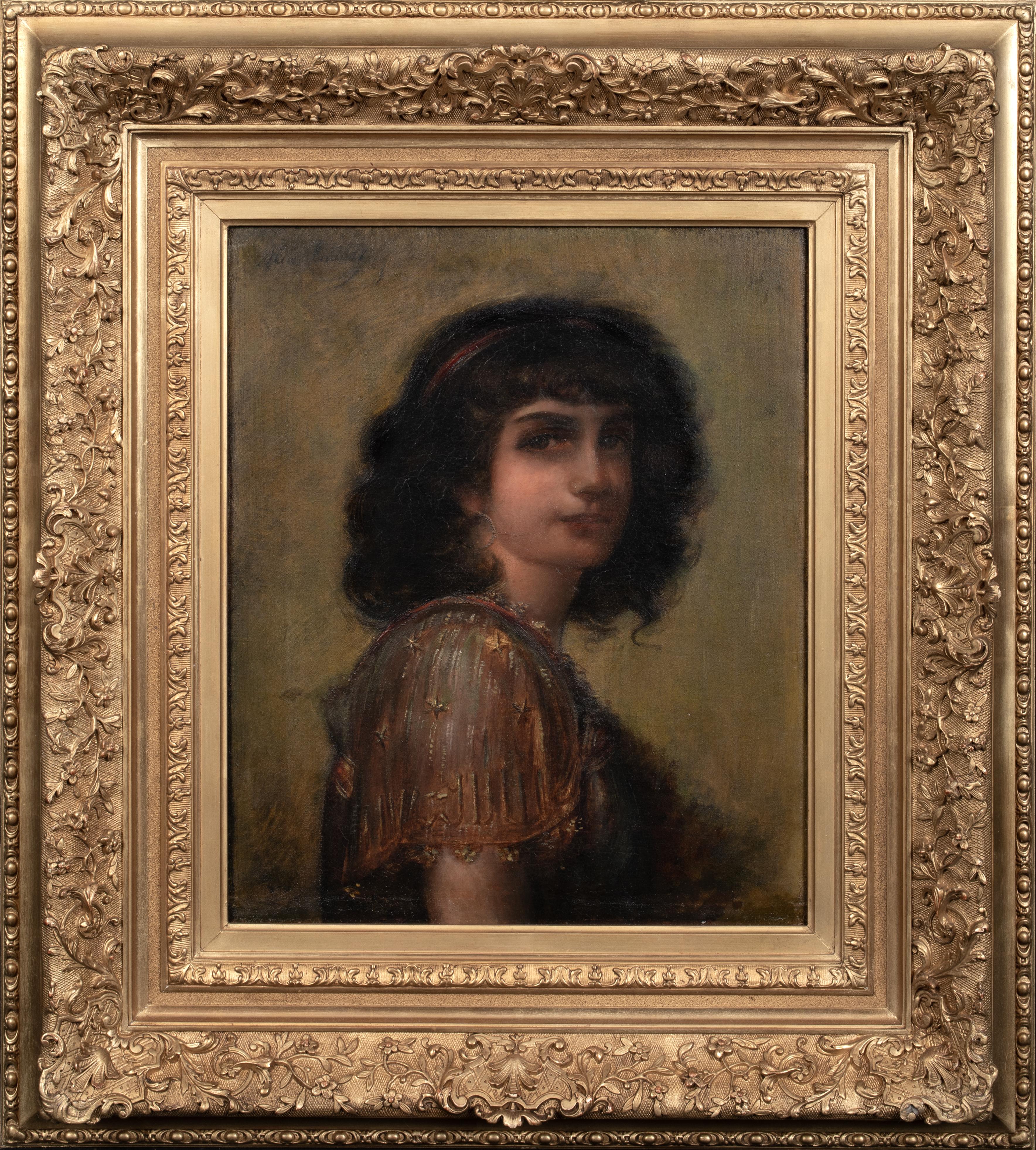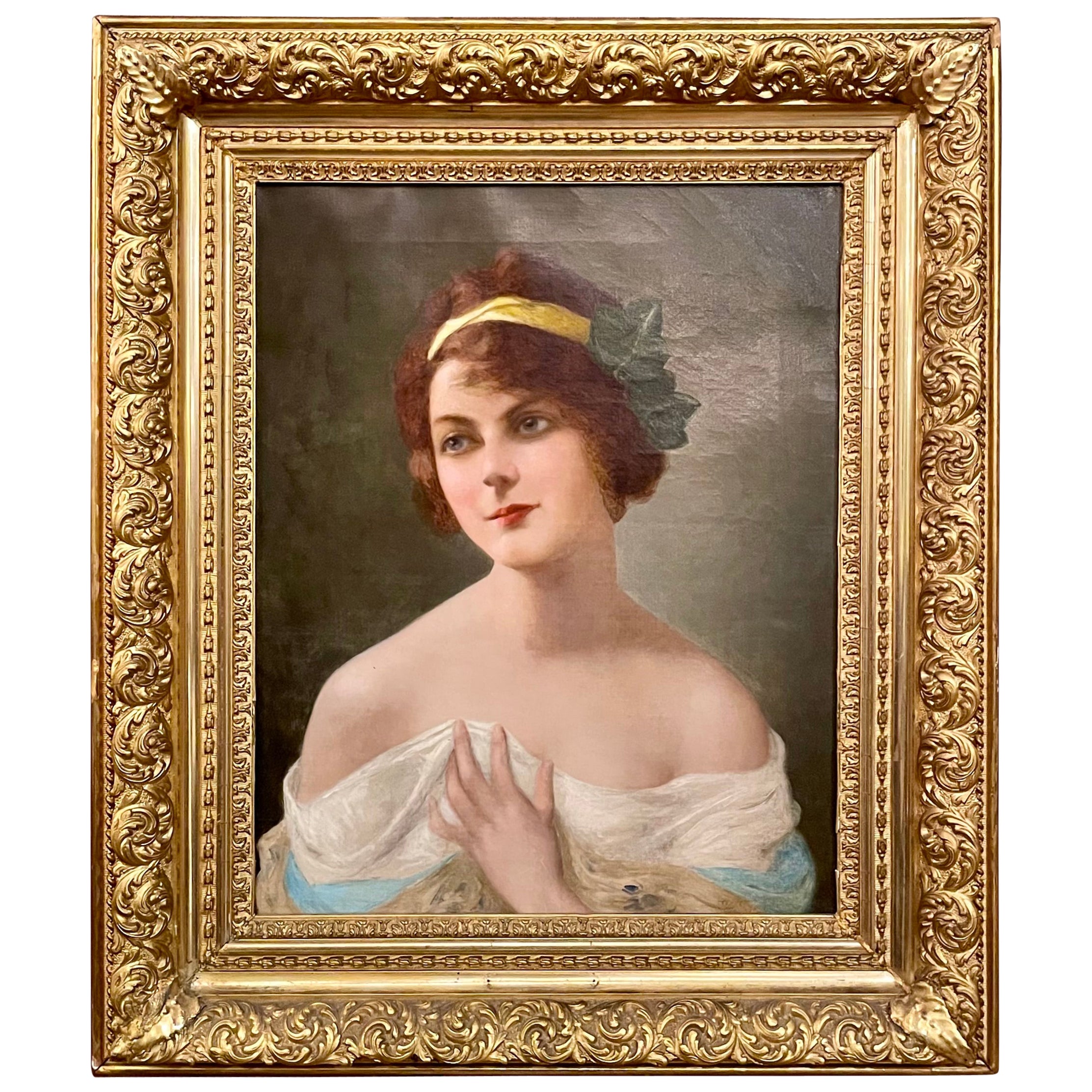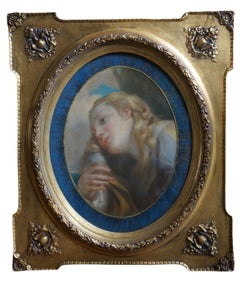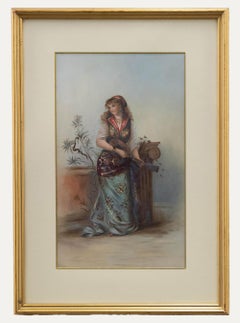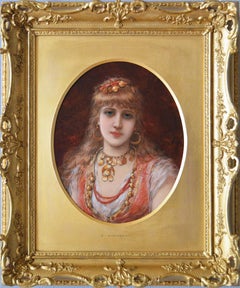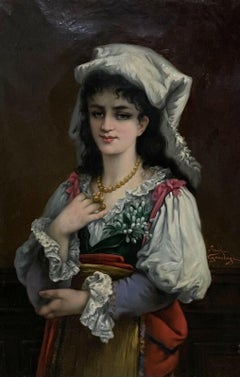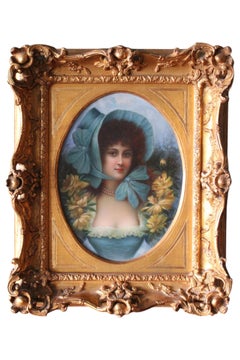Items Similar to Portrait of a Circassian courtisane, in original 19th century frame, orientalist
Want more images or videos?
Request additional images or videos from the seller
1 of 12
Anton EbertPortrait of a Circassian courtisane, in original 19th century frame, orientalist
$5,385.16
£4,000.28
€4,500
CA$7,429.21
A$8,166.74
CHF 4,292.07
MX$99,174.02
NOK 53,542.44
SEK 50,727.70
DKK 34,256.33
About the Item
Anton Ebert (1845-1896)
A celebrated painter born in a noble familie in castle kladrau in mies, bavaria. His father was royal
treasurer. He studied in Prague, Bohemia and made carreer in Vienna.
Kaiser Frans Joseph (1830-1916) and his wife Sissi von Wittelsbach (1854-1898) commissioned portraits von Anton
Ebert. He was wellknow for female portraits and works in the orientalist style. This portrait depicts a Circassian
courtisane and belongs to the orientalist style.
Oil on canvas
Signed lower left A. Ebert. Wien
In original 19th century frame
Dimesions excl. frame: 48 x 37 cm.
Dimensions incl. frame: 56 x 45 cm.
As an artist, Anton Ebert was particularly skilled in painting the human figure, especially children and young women.
Ebert was born on 6th June 1845 at Kladrau Castle near Mies, Bavaria, home of the noble Windisch-Graetz family, where Anton spent much of his youth as the son of the royal treasurer at Klandrau. Like his elder brother Ludwig (b. 1834), who was also born at Kladrau and went on to make his name as concertmaster to the Grand Duke in Vienna and as first cellist of the Gurzenich Orchestra in Cologne, Anton was born with a strong artistic talent. In recognition of this, he was sent to the Prague Akademie and from there to Vienna, where he studied under the Austrian Romantic painter Ferdinand Georg Waldmüller (1793-1865), whose wide repertoire of subjects included genre scenes, often of young children and their mothers, portraits, landscapes and a few Orientalist scenes. Waldmüller's academic style, his fresh palette as well as his subject matter were all to exert a strong influence on Anton, who throughout his relatively short career painted in a similar traditional manner.
Like Waldmüller, Ebert tended to paint portraits, which provided a staple income as well as genre scenes and a few Orientalist beauties. Ebert enjoyed a thriving portrait practise whose sitters included royalty, aristocracy and society figures. Among them was the American born soprano singer Minnie Hauck (exhibited at the Vienna Künstlerhaus). He also painted a portrait of Sissi-Elizabeth of Wittlesbach, as the young wife of the Emperor Franz Josef I as well as one of Prince Windisch-Graetz, governor of Mainz, whose portrait is now in the Mainz Art Gallery. Added to this Ebert also painted a number of self-portraits including one of 1892, which he gave to the Kaiser's own collection and is now in the Museum of Vienna.
Many of Ebert's genre scenes, especially those of young children were drawn from memories of his own childhood at Kladrau Castle and from contemporary scenes of Windisch-Graetz family as they grew up.
Ebert's ties with Kladrau continued throughout his life and it was probably through the Windisch-Graetz family that he was commissioned to paint an altarpiece for St Peters Church at Kladrau. During the latter part of his life Ebert also painted a number of landscapes predominantly showing scenes around Vienna where he was then living and where he died on 16th June 1896, just before his 51st birthday. It was also in Vienna that he exhibited at its Künstlerhaus as well as at other venues between 1868 and 1888. In addition to those museums mentioned above, Ebert's oeuvre is represented at the Roumianzeff Museum, Moscow with a scene of a mother and her children, and at Stettin Nationalmuseum with a scene entitled "At the Fountain" of 1878.
(artvee)
Circassian beauty
Circassian beauty is a stereotype and a belief referring to the Circassian people. A fairly extensive literary history suggests that Circassian women were thought to be unusually beautiful and attractive, spirited, smart and elegant, and as such were desirable (although most Circassians traditionally refused to marry non-Circassians in accordance with Adyghe Xabze). A smaller but similar literature also exists for Circassian men, who were thought to be especially handsome.
There are folk songs in various languages all around the Middle East and Balkans describing the unusual beauty of Circassian women, a trend popularised after the Circassian genocide, although the reputation of Circassian women dates back to the Late Middle Ages when the Circassian coast was frequented by traders from Genoa, and the founder of the Medici dynasty, Cosimo de' Medici, had an illegitimate son from a Circassian slave, Maddalena. During the Ottoman Empire and Persian Safavid and Qajar dynasties, Circassian women living as slaves in the Sultan's Imperial Harem and Shah's harems started to build their reputation as extremely beautiful, which then became a common trope in Western Orientalism.
(Wikipedia)
- Creator:Anton Ebert (1845 - 1896, Austrian)
- Dimensions:Height: 22.05 in (56 cm)Width: 17.72 in (45 cm)
- More Editions & Sizes:48 x 37 cm.Price: $5,385
- Medium:
- Period:
- Condition:
- Gallery Location:DEVENTER, NL
- Reference Number:1stDibs: LU2366213885242
About the Seller
5.0
Vetted Professional Seller
Every seller passes strict standards for authenticity and reliability
Established in 2015
1stDibs seller since 2023
9 sales on 1stDibs
Typical response time: 1 hour
- ShippingRetrieving quote...Shipping from: DEVENTER, Netherlands
- Return Policy
Authenticity Guarantee
In the unlikely event there’s an issue with an item’s authenticity, contact us within 1 year for a full refund. DetailsMoney-Back Guarantee
If your item is not as described, is damaged in transit, or does not arrive, contact us within 7 days for a full refund. Details24-Hour Cancellation
You have a 24-hour grace period in which to reconsider your purchase, with no questions asked.Vetted Professional Sellers
Our world-class sellers must adhere to strict standards for service and quality, maintaining the integrity of our listings.Price-Match Guarantee
If you find that a seller listed the same item for a lower price elsewhere, we’ll match it.Trusted Global Delivery
Our best-in-class carrier network provides specialized shipping options worldwide, including custom delivery.More From This Seller
View AllMary Magdalene, pastel on paper, relates to Correggio’s Il giorno, antique frame
Located in DEVENTER, NL
Mary Magdalene
Signed and dated lower left: Vivien J 1734
pastel on paper,
In 19th century gilt frame
Dimensions: oval: 47 x 34 cm,
Dimensions incl. frame: 80 x 69 cm.
The pastel ...
Category
19th Century Portrait Paintings
Materials
Paper, Pastel
Antique oil painting on panel, interior scene with a cat, Belgium, 19th century
Located in DEVENTER, NL
Franciscus Melzer (1808-1865)
Interior painting with a cat that gives out a scratch
Signed lowerright corner F. Melzer
Oil on mahogany wooden pane...
Category
19th Century Flemish School Animal Paintings
Materials
Oil, Wood Panel
Portrait of Mrs. Stokdijk-Chasler, oil on canvas
Located in DEVENTER, NL
John Archibald Alexander Berrie (1887-1962)
Potrait of Mrs. Stokdijk-Chasler
Signed lower right John A. A. Berrie (underneath the frame)
Oil on canvas
Dimensions: 100 x 76 cm.
Cond...
Category
Mid-20th Century Portrait Paintings
Materials
Canvas, Oil
Antique Dutch oil painting on panel, traveler horseback with a dog, ca. 1835
Located in DEVENTER, NL
Painting with a traveler on a white horse and accompanied by a dog looking up at a road sign in the form of a cross. On the roadsign is ” Arnhem”. (a town at the Rhine river in the E...
Category
1830s Romantic Figurative Paintings
Materials
Oil, Wood Panel
Decorative river landscape in romantic style, oil on canvas
Located in DEVENTER, NL
Decorative river landscape in romantic style,
Signed lower left 'I Roy', unknown artist,
Oil on canvas
Dimensions excl. frame: 49 x 65
Dimensions incl. frame: 64 x 80 x 7 cm.
In go...
Category
20th Century Romantic Landscape Paintings
Materials
Canvas, Oil
Portrait of a well-to-do gentleman
Located in DEVENTER, NL
Portrait of a well-to-do gentleman in pastel on parchment.
Signed left: Marteau L. 1760.
French School, possibly by Louis Marteau (1715 – 1804)
In a gilded 19th century frame.
Dimen...
Category
18th Century Portrait Paintings
Materials
Parchment Paper, Pastel
You May Also Like
Framed Late 19th Century Oil - Portrait of a Turkish Performer
Located in Corsham, GB
A beautiful oil study of a Turkish performer playing folk music on the Oud. The lady wears an elegant wrap skirt with floral motifs, matched with a colourful waistcoat and silk blous...
Category
Late 19th Century Portrait Paintings
Materials
Oil
$479 Sale Price
20% Off
19th Century portrait oil painting of young woman
By Émile Eisman-Semenowsky
Located in Nr Broadway, Worcestershire
Émile Eisman-Semenowsky
French/Polish, (1857-1911)
Eastern Beauty
Oil on panel, oval, signed & inscribed Paris
Image size: 10.25 inches x 8.25 inches (oval)
Size including frame: 18...
Category
19th Century Portrait Paintings
Materials
Oil, Panel
Fine 19th Century Italian Signed Oil Painting Portrait of Young Lady, Gilt Frame
Located in Cirencester, Gloucestershire
Artist/ School: Italian School, 19th century. indistinctly signed
Title: Portrait of a Young Country Lady
Medium: signed oil painting on canvas, framed.
framed: 31.25 x 23 inches
...
Category
19th Century Victorian Portrait Paintings
Materials
Oil
Antique portrait 19th Century oil painting of a woman by Adolphe Philippe Millot
Located in AIGNAN, FR
Antique portrait painting of a woman by French artist, Adolpe Millot (1857-1921) in a very attractive gold frame. A beautiful woman looks out at the viewer, her head covered by a lar...
Category
1880s Romantic Portrait Paintings
Materials
Oil
Portrait Of A Gipsy Girl, 19th Century by Alix Louise ENAULT (1860-1913)
Located in Blackwater, GB
Portrait Of A Gipsy Girl, 19th Century
by Alix Louise ENAULT (1860-1913) to $40,000
Large 19th Century French portrait of a young gipsy girl, possibly portrayed as Esmeralda, oil on canvas by Alix Louise Enault. Excellent quality and condition leading example of the famous french female painters...
Category
19th Century Portrait Paintings
Materials
Canvas, Oil
Antique 19th Century Russian Oil on Canvas Painting, Portrait of a Young Lady.
Located in New Orleans, LA
Antique 19th Century Russian Oil on Canvas Painting, Portrait of a Young Lady, by Vincent Stiepevich (1841-1910).
Category
Antique 19th Century Russian Paintings
Materials
Canvas, Wood, Paint
More Ways To Browse
19th Century Orientalist Paintings
The Cellist
Persian Qajar
Antique Persian Qajar
19th Century American Folk Art Portraits
The Sopranos
Franz Josef
Anton Ebert
Ebert Oil Painting
Sultan Harem
Vintage Green Lady Painting
American Indian Portraits
Dylan Farrell
Hyacinthe Rigaud
Organ Grinder
Portrait 1903
Portrait Armor
Spain Old Masters
